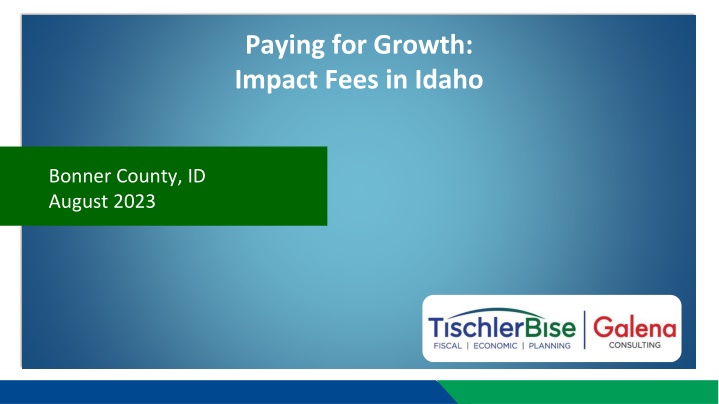
Impact Fees and Infrastructure Financing Strategies in Idaho
Explore the use of impact fees for growth-related infrastructure in Bonner County, Idaho, and the impact of recent legislation on tax revenue generation. Learn about the fundamentals of impact fees, eligible costs, and requirements for maintaining and spending fee revenue in Idaho. Stay informed about the importance of impact fees in supporting growth and infrastructure development.
Download Presentation

Please find below an Image/Link to download the presentation.
The content on the website is provided AS IS for your information and personal use only. It may not be sold, licensed, or shared on other websites without obtaining consent from the author. If you encounter any issues during the download, it is possible that the publisher has removed the file from their server.
You are allowed to download the files provided on this website for personal or commercial use, subject to the condition that they are used lawfully. All files are the property of their respective owners.
The content on the website is provided AS IS for your information and personal use only. It may not be sold, licensed, or shared on other websites without obtaining consent from the author.
E N D
Presentation Transcript
Paying for Growth: Impact Fees in Idaho Bonner County, ID August 2023
Impact fees/infrastructure financing strategies Fiscal/economic impact analyses Capital improvement planning Infrastructure finance/revenue enhancement Real estate and market feasibility 2 TischlerBiseGalena | www.tischlerbise.com
Background Impact fees have been used in Idaho for over 25 years Significant growth throughout Idaho is creating a new wave of pushback from existing property tax payers HB 389 in 2021 further reduced the ability of counties to generate tax revenue to support growth Demands for growth to pay its own way are leading to new interest in the use of impact fees for County infrastructure 3 TischlerBiseGalena | www.tischlerbise.com
Impact Fee Fundamentals One-time payment for growth-related infrastructure, usually collected at the time buildings permits are issued Complexity with fire/EMS district impact fees Not a tax, similar to a contractual arrangement to build infrastructure with fee revenue, with three requirements Need (system improvements, not project-level improvements) Benefit Short range expenditures Geographic service areas and/or benefit districts Proportionate 4 TischlerBiseGalena | www.tischlerbise.com
Eligible Costs Facilities/improvements required to serve new development Yes Excess capacity in existing facilities Yes Improvements required to correct existing deficiencies No Unless there is a funding plan Maintenance and repairs No Operating costs No 5 TischlerBiseGalena | www.tischlerbise.com
Impact Fees in Idaho Impact fee revenue must be maintained in an interest bearing account Monies must be spent within 8 years from collection Community must publish an Annual Monitoring Report and have Advisory Committee Capital improvement plan (CIP) is required Comprehensive review and update every 5 years Eligible for the following public facilities with useful life of 10 years or more: Water, wastewater, stormwater Transportation Parks & Recreation Public safety: law enforcement, fire, EMS 6 TischlerBiseGalena | www.tischlerbise.com
Why Impact Fees? Infrastructure capacity is essential to accommodate new development New growth pays its equitable share Encourages disciplined capital improvement planning Earmarks money for capital improvements Promotes comprehensive planning and growth management Helps ensure adequate public facilities Compared to negotiated agreements, streamlines approval process with known costs (predictability) Anti-growth pressure can be eased, time equity 7 TischlerBiseGalena | www.tischlerbise.com
Myths and Misconceptions Impact fees cover the entire cost of new facilities, negating the need for higher taxes Market considerations Credits How about the O&M costs? Impact fees should be based on planning standards, without concern for deficiencies Nonresidential fees can be adjusted for economic reasons All developers/builders hate impact fees 8 TischlerBiseGalena | www.tischlerbise.com
Common Impact Fee Methods Cost Recovery (past) Oversized and unique facilities Funds typically used for debt service Incremental Expansion (present) Formula-based approach documents level of service with both quantitative and qualitative measures Plan-Based (future) Common for utilities but can also be used for other public facilities with non- impact fee funding 9 TischlerBiseGalena | www.tischlerbise.com
Evaluate Need for Credits Debt service Avoid double payment due to existing or future bonds Dedicated revenues e.g., property tax, local option sales tax, grants Site specific Developer constructs a capital facility included in fee calculations 10 TischlerBiseGalena | www.tischlerbise.com
Impact Fee Study Process Report can typically be completed in 3-4 months, 2-3 months for adoption Determine existing development base and projected future growth Determine existing levels of service and capital needs due to new growth Determine appropriate indicators of demand Evaluate methodological alternatives Evaluate need for credits Calculate fees Review and input from Advisory Committee/other stakeholder groups Adoption process 11 TischlerBiseGalena | www.tischlerbise.com
Bonner County Existing/under review impact fees in the area City of Sandpoint, City of Priest River, Sagle Fire, West Pend Oreille Fire, Northside Fire CDA, City of Post Falls, City of Hayden, fire and EMS districts in Kootenai County If County study includes countywide infrastructure, IGAs are needed so that the County impact fees are collected when building permit is issued City can include an admin fee during the process 12 TischlerBiseGalena | www.tischlerbise.com
Bonner County Impact fees cannot be used to address current deficiencies i.e., a bridge or intersection that have had deferred maintenance Many of the items in the 2018 Transportation Plan would not be impact fee eligible Best if Impact Fee Study Transportation CIP is countywide benefiting If not, study can explore service areas Nexus for a public safety impact fees tends to be easier, ripple effect of service New stations, apparatus, equipment 13 TischlerBiseGalena | www.tischlerbise.com
Bonner County Sheriff, EMS, transportation impact fee components priced separately in proposal 5-month timeline Fee collection will pay back the study cost over five years In the past five years, impact fees could ve funded $3-$5 million in infrastructure 14 TischlerBiseGalena | www.tischlerbise.com
Thank you Colin McAweeney TischlerBiseGalena Boise, ID I 208.515.7480 I colin@tischlerbise.com 15 TischlerBiseGalena | www.tischlerbise.com
